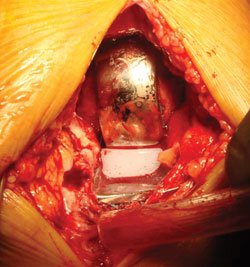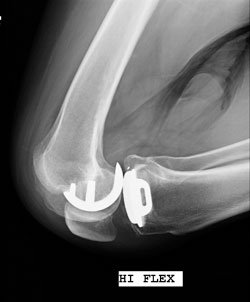Compartmentalist approach to knee arthroplasty growing in viability
As a less invasive and more conservative treatment, it may be ‘a natural progression.’
Increasing experience with unicompartmental knee arthroplasty is turning it into a more viable option for treating isolated lateral or patellofemoral arthritis — but more work is needed to determine exactly what the inclusion and exclusion criteria should be, according to an orthopedic surgeon from Ohio.
Keith R. Berend, MD, discussed his findings with an audience at the Current Concepts in Joint Replacement 2010 Winter Meeting in Orlando, Fla.
Movement toward unicompartmental knee arthroplasty (UKA) seems to be “a natural progression” given its conservative and less invasive nature when compared to total knee arthroplasty, Berend said, noting that early experience with a mobile bearing medial UKA shows excellent function and 98% survivorship throughout 6 years.
“Partial knee arthroplasty is by definition the only minimally invasive technique for the treatment of isolated, single compartment osteoarthritis of the knee,” Berend told Orthopedics Today. “Additionally, in the case of medial partial knee, significant amounts of patellar disease seen on preoperative radiographs can safely be ignored as these findings do not seem to affect survivorship.”
The “classical” indications
|
|
Berend’s investigation looked into the “classical” indications and contraindications associated with medial UKA, determining how it impacted results in a consecutive series of 1,500 medial UKAs implanted for anteromedial osteoarthritis (OA).
“I think if we are going to look at a compartmentalist’s approach, we need to understand what the indications or perhaps the necessary contraindications are for treating the knee compartmentally,” he said.
The first criteria examined were weight and age, wherein Berend found no difference in survivorship among patients heavier than 180 lbs, having a BMI over 32, or being younger than 60 years. Further investigation of BMI was performed with Berend’s series and that of an Oxford group, resulting in 2,586 consecutive UKA being analyzed. Reportedly, survival in 764 UKA with a BMI of 30 to 35 was 94%, with BMI of 36 to 40 having a survivorship of 95% and BMI of more than 40 having a survivorship of 98%.
“So to lump them all together and say obesity is a contraindication … does not allow us to have a compartmentalist view,” Berend said. “In fact, it is not a contraindication.”
Patellofemoral and lateral
To examine the patellofemoral compartment, Berend said a blinded evaluator looked at standardized radiographs from 626 knees in which a mobile bearing medial UKA was implanted. The Altman classification was used to grade levels of sclerosis, osteophytes and joint space narrowing. In those patients, Berend reported, 17 underwent revision — a survivorship rate at 6 years of 97%.
|
|
Image: Berend KR |
However, he added, the most important figure was the survivorship rate based on whether the patient had a normal patellofemoral joint (94%) or significant bone-on-bone in the medial facet (97%).
“I think we need to treat the disease process, and not the indications or contraindications that have not really been proven in the literature,” Berend said.
As for lateral OA, which Berend said is often overlooked but represents approximately 10% of OA cases, the study looked at 132 lateral UKA patients with bimodal distribution across young, active women or elderly men and women.
“There are certain tips, tricks and techniques that make lateral compartmental arthroplasty easier or more difficult,” Berend said. “One of those is doing a lateral peripatellar approach and growing more comfortable with that.”
With a follow-up of 25 months, Berend reported no device-related failures, two reoperations, and higher pain, clinical and functional scores than in any subsets of total knee patients.
Urged toward compartmentalism
Though more work is needed to gain proper experience and learn more of the indications for UKA, Berend said there are numerous reasons for pursuing it as an alternative to more invasive options.
“Partial knee arthroplasty, whether it be medial, lateral, or patellofemoral, is truly the only minimally invasive approach that we can offer patients, and I would urge you to take this compartmentalist approach,” he concluded. “I think it makes treating the arthritic knee effective, but it also makes sense and it would certainly make things easier.” – by Robert Press
References:
- Berend KR. Uniopolis, USA: A compartmentalist approach. Paper #71. Presented at the Current Concepts in Joint Replacement 2010 Winter Meeting. December 8-11, 2010. Orlando, Fla.
- Berend KR, et al. Clin Orthop Relat Res. 2005;(440): 60-66.
- Berend KR, et al. Orthopedics. 2007; 30(5 Suppl):19-23.
- Price AJ, et al. A second decade lifetable survival analysis of the Oxford unicompartmental knee arthroplasty. Clin Orthop Relat Res. 2011;469(1):174-179.
- Price AJ, et al. Clin Orthop Relat Res. 2005;435: 171-180.
- Keith R. Berend, MD, can be reached at Joint Implant Surgeons, 7277 Smith’s Mill Road, Ste. 200, New Albany, Ohio 43054; 614-221-6331; e-mail: BerendKR@joint-surgeons.com.
Disclosure: Berend has stock options for the advisory committee of Angiotech, receives royalties and consulting fees from Biomet Orthopedics, and receives consulting fees from Salient Surgical Technologies and Synvasive.
Dr. Berend rightfully questions the contraindications of obesity, concomitant patellofemoral wear and isolated lateral compartment wear based on his considerable experience in 1,500 mobile bearing UKAs with a follow-up of 6 years. His questioning of the obesity contraindication in medial UKA is justified, as survivorship increased with BMI in the ranges from 30 to 35 and 36 to 40 and greater than 40 BMI. His use of a medial UKA in patients with medial patella facet arthritis is justified, as those patients had better survivorship than those with a normal patellofemoral joint. Lastly, he shared his experience in treating the relatively common group of patients that present with isolated lateral degenerative arthritis (10%) that were treated with lateral UKA implanted with a lateral approach. Although the follow-up at 25 months is short, his high early survivorship of lateral UKA encourages further long-term study. We look forward to a report showing that the use of UKA in a patient with obesity, concomitant patellofemoral wear or isolated lateral compartment wear has at least the same level of pain relief and function (Oxford, WOMAC Scores) as the use of a UKA in a patient with classic indications.
– Stephen M. Howell, MD
Orthopedic
Surgeon
Sacramento, Calif.
Disclosure: Howell is a consultant to
and receives royalties from Biomet Sports Medicine Inc., and he is an unpaid
consultant to and a stockholder in OtisMed Inc.



